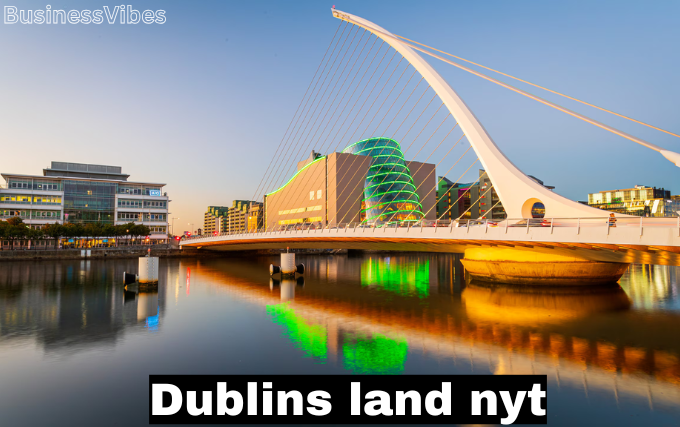Dublin, the capital of Ireland, is a city with a rich history, vibrant culture, and an intriguing relationship with its land. Over the centuries, Dublin’s land has evolved from a Viking settlement to a modern European capital, marked by its unique urban design, historical landmarks, and deep connection to its natural environment. The term “Dublin’s land” encapsulates not just its geography, but also its historical, economic, and cultural significance, which continues to shape the city today.
The Historical Foundations of Dublin’s Land
Dublin’s Viking Origins
Dublin’s history dates back to 841 AD, when it was founded by Viking settlers. Known originally as Dubh Linn, meaning “Black Pool” in Irish, the city was strategically located along the River Liffey. The land was fertile and provided a natural harbor, making it an ideal location for trade and settlement.
The Norman Influence
By the 12th century, the Normans had taken control of Dublin, bringing with them new land management techniques and architectural styles. The introduction of castles, such as Dublin Castle, and the expansion of trade routes helped solidify Dublin’s importance as a medieval hub.
Land and British Rule
Under British rule, Dublin’s land underwent significant transformations. Large estates were established, often owned by wealthy landlords, while the rural areas around Dublin were cultivated for agriculture. The city center became a focal point for political and cultural activity, particularly during the Georgian era.
Urban Development and the Shaping of Modern Dublin
The Georgian Era: Architectural and Urban Planning Legacy
The 18th century marked a transformative period for Dublin’s urban landscape. During the Georgian era, the city saw the construction of grand squares and streets, such as St. Stephen’s Green, Merrion Square, and Fitzwilliam Square. These developments emphasized symmetry, open spaces, and elegance, which remain hallmarks of Dublin’s land today.
Industrial Revolution and Expansion
The Industrial Revolution brought significant changes to Dublin’s land use. Railways, factories, and housing developments sprang up, particularly in the north and south suburbs. However, the rapid urbanization also led to overcrowding and poor living conditions in some areas.
Independence and Urban Renewal
Following Irish independence in 1922, Dublin experienced a period of urban renewal. Efforts were made to preserve historical landmarks while modernizing the city to accommodate its growing population. Areas like Temple Bar, once neglected, were revitalized to become cultural and economic hubs.
Cultural Significance of Dublin’s Land
Dublin as a Literary Capital
Dublin’s land has inspired countless writers, earning it the title of a UNESCO City of Literature. The city’s streets, parks, and landmarks have been immortalized in works by literary giants like James Joyce, Oscar Wilde, and W.B. Yeats. Joyce’s Ulysses famously chronicles a day in the life of Dublin, capturing the essence of its land and people.
Festivals and Cultural Celebrations
Dublin’s land is often the stage for vibrant festivals and cultural events. From St. Patrick’s Day parades to the Dublin Fringe Festival, the city’s public spaces play a crucial role in bringing its community together.
Landmarks of Cultural Importance
- Trinity College Dublin: Home to the famous Book of Kells and surrounded by lush green spaces, Trinity College is one of Dublin’s most iconic landmarks.
- Phoenix Park: One of the largest urban parks in Europe, it symbolizes Dublin’s commitment to preserving natural land within the urban environment.
- Kilmainham Gaol: A stark reminder of Ireland’s struggle for independence, this historic site attracts thousands of visitors each year.
Economic Importance of Dublin’s Land
A Hub for Business and Innovation
Dublin’s land is home to major global corporations, particularly in the tech industry, with areas like the Silicon Docks housing companies such as Google, Facebook, and LinkedIn. This has transformed Dublin into one of Europe’s leading economic centers.
Real Estate and Urban Challenges
As Dublin grows, its land has become a focal point of debate. Rising property prices and housing shortages are pressing issues, reflecting the challenges of balancing urban development with affordability and sustainability.
The Natural Beauty of Dublin’s Land
The River Liffey
The River Liffey is central to Dublin’s geography, dividing the city into its northern and southern halves. It has served as a lifeline for trade, transportation, and recreation throughout Dublin’s history.
Coastal Wonders
Dublin’s coastal areas, including Howth, Dún Laoghaire, and Sandymount Strand, offer breathtaking views and a connection to Ireland’s maritime heritage. These areas attract locals and tourists alike, providing a serene escape from the urban core.
Green Spaces
Dublin’s commitment to preserving green spaces is evident in its numerous parks and gardens. In addition to Phoenix Park, locations like Iveagh Gardens and Herbert Park provide urban dwellers with natural retreats.
Modern-Day Challenges and Future of Dublin’s Land
Urban Sprawl and Sustainability
Dublin faces challenges related to urban sprawl, traffic congestion, and environmental sustainability. Efforts are underway to promote green building practices, improve public transportation, and protect natural habitats.
Housing and Affordability
The demand for land in Dublin has driven up housing costs, making it difficult for many residents to afford homes. Initiatives to address this issue include the development of affordable housing projects and policies to regulate the rental market.
Climate Change and Resilience
As a coastal city, Dublin is vulnerable to the impacts of climate change, including rising sea levels and flooding. Investments in resilient infrastructure and environmental conservation are critical to safeguarding Dublin’s land for future generations.
Dublin’s Land in Popular Media and Literature
Dublin in The New York Times
The keyword “Dublin’s land NYT” hints at the portrayal of Dublin’s geography and cultural significance in The New York Times. Articles and features often highlight Dublin’s unique blend of historical charm and modern vibrancy, attracting global attention to its land and legacy.
Film and Television
Dublin’s iconic locations, such as Ha’penny Bridge and Dublin Castle, have appeared in numerous films and TV series, further cementing its status as a cultural landmark.
Conclusion
Dublin’s land is more than just a physical space; it is a tapestry woven with history, culture, and community. From its Viking roots to its modern role as a global city, Dublin’s land reflects the resilience and creativity of its people. As the city continues to evolve, the challenges and opportunities associated with its land will shape its future, ensuring that Dublin remains a dynamic and inspiring place for generations to come.







